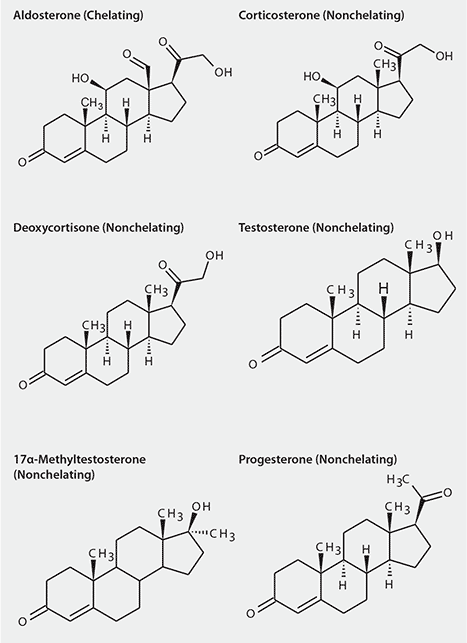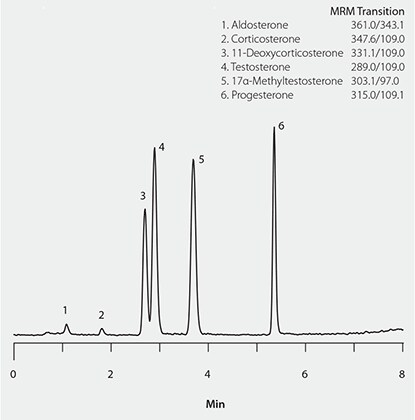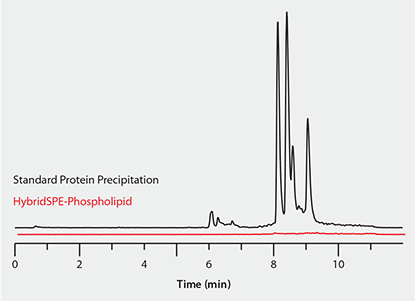LC/MS/MS Analysis of Steroid Hormones in Plasma
Craig Aurand
Reporter US Volume 32.2
HybridSPE®-Phospholipid plates provided excellent analyte recovery of these difficult compounds from plasma samples with subsequent LC/MS/MS analysis on Ascentis® Express Fused-Core® C18 columns. The extracts were free of endogenous phospholipids that can interfere with quantitation, decrease sample throughput and reduce column lifetime.
Introduction
There is a growing trend toward converting some clinical methods from immunoassay to LC/MS/MS for a variety of reasons. LC/MS/MS improves assay specificity, is not limited by antibody availability, and allows multiplexed analyte assays to be conducted simultaneously. However, LC/MS/MS is not without its limitations, most notably interferences from endogenous sample matrix, which can result in seemingly random and arbitrary discrimination in analyte response, among other effects1.
Objectives of the Study
The goal of this study was two-fold. First, to develop a simple LC/ MS/MS method, including sample preparation using HybridSPEPhospholipid plates, for the direct analysis of the steroid hormones progesterone, aldosterone, corticosterone, deoxycorticosterone, testosterone, and 17α-methyltestosterone from blood plasma. Second, to compare the background from sample matrix between the resultant sample prep method to standard protein precipitation. samples.
Experimental
Chromatographic (LC/MS/MS) Conditions
The chemical structures of the steroid hormones are shown in Figure 1. Initial evaluation was conducted using a mixture of steroid hormones to establish chromatographic conditions on Ascentis Express C18 column. The gradient profile was extended so matrix monitoring could be conducted for the processed plasma

Figure 1. Structures of Steroid Hormones
HybridSPE-Phospholipid Operating Principles
HybridSPE-Phospholipid technology combines simple, standardized methodology of protein precipitation with the specificity of solid phase extraction for the simultaneous removal of proteins and phospholipids from biological samples. The technology is based on hybrid zirconia-silica particles for targeted isolation of phospholipids, while PTFE frit materials act as a depth filter for efficient removal of precipitated protein particles. The zirconia portion of the hybrid particle behaves as a Lewis acid (electron acceptor) which interacts strongly with Lewis bases (electron donors), like the phosphate moiety of phospholipids. This technology allows for highly selective phospholipid matrix removal while remaining non-selective towards a broad range of analytes2.
Sample Prep Method Development: Factors that Impact Analyte Recovery
Sample prep method development consisted of establishing recovery of standard compounds from the HybridSPE-Phospholipid 96-well plates, then transferring those conditions for use with spiked plasma samples. Method optimization consisted of evaluating several precipitation solvent systems. Once sufficient analyte recovery was established for the plasma samples, the final portion of the study was to compare the HybridSPE-Phospholipid technique with the commonly accepted protein precipitation for phospholipid matrix removal.
Recovery of Analytes from Standard Solution using HybridSPE-Phospholipid
Method development with the HybridSPE-Phospholipid 96-well plate began with establishing recovery of the six steroids from standard solutions. External standard calibration curves from 10 to 300 ng/mL of each compound in 1% (v/v) formic acid acetonitrile:water (3:1) were developed. A 300 µL aliquot of standard solution (50 ng/mL) was added to the HybridSPE-Phospholipid 96-well plate. Vacuum was applied for 4 minutes at 10” Hg. Samples were then analyzed directly.
Recovery of Analytes from Plasma using HybridSPE-Phospholipid
The primary solvent used with the HybridSPE-Phospholipid for precipitation of plasma samples is 1% (v/v) formic acid in acetonitrile. Used in a 3:1 ratio with the plasma sample, this solution effectively precipitates plasma proteins. Formic acid also disrupts binding of target analytes with proteins, providing increased sensitivity. However, with analytes with chelating properties, the use of 0.5% (w/v) citric acid in acetonitrile as the precipitation additive and in a preconditioning step greatly increases their recovery from the zirconia-silica particles.
Formic Acid System: 1% (v/v) formic acid in acetonitrile:water (3:1)
Rat plasma stabilized with K2EDTA (Lampire Biological Laboratories, Pipersville PA) was spiked with the analytes from a standard solution. A 100 µL aliquot was added to the HybridSPE-Phospholipid plate followed by 300 µL of 1% formic acid acetonitrile precipitation solvent. The plate was agitated via vortex for 4 minutes, placed on vacuum manifold and subjected to 10” Hg vacuum for 4 minutes. The filtrate was collected and analyzed directly. The concentration of steroid hormones in the final sample work up was equivalent to 50 ng/mL. Recovery was based on interpolation of a standard curve of analytes in buffer.
Citric Acid System: 0.5% (w/v) citric acid in acetonitrile, for chelating compounds
The citric acid procedure was the same as the formic acid procedure described above, except for these two steps: The precipitation solvent was 0.5% (w/v) citric acid in acetonitrile. The HybridSPE-Phospholipid plate was first preconditioned with 300 µL/well of 0.5% (w/v) citric acid in acetonitrile.
Monitoring Phospholipids from the Plasma Sample Matrix
Spiked plasma samples were precipitated using 0.5% citric acid acetonitrile and analyzed directly. Phospholipid monitoring was conducted using Q3 full scan along with precursor ion scan of 104 m/z. Gradient chromatographic conditions utilized for the assay enable elution of phospholipids under high organic conditions.
Results and Discussion
The gradient elution of the six steroid hormones on the Ascentis Express C18 with LC/MS/MS detection is shown in Figure 2.

Figure 2. LC/MS/MS Analysis of Steroid Hormones
Conditions
column: Ascentis Express C18, 10 cm x 2.1 mm I.D., 2.7 µm (Product No. 53823-U); mobile phase: (A) 5 mM ammonium formate, pH 4.0 with formic acid; (B) methanol; gradient: 60% B for 3 min, to 95% B in 5 min, held at 95% B for 2 min; flow rate: 0.3 mL/min; column temp: 50 °C; pressure: 90 bar detector: ESI(+), MRM; injection: 2 µL; sample: 50 ng/mL of each compound; system: Shimadzu LC-30AD, LCMS-8030
Analyte Recovery
Table 1 presents the recovery data of the steroid compounds extracted by the HybridSPE-Phospholipid plates from a standard solution using the formic acid system, and from spiked plasma using the formic acid and citric acid systems. The table reports average observed concentration, standard deviation and coefficient of variation (% c.v.) of replicate samples (n=8).
In the formic acid system, with the standard solutions, poor recovery and high variability of aldosterone, corticosterone and deoxycorticosterone were observed. This is due to chelation of the combined carbonyl/carboxylic acid site on these molecules with the zirconia-silica surface of the HybridSPE- Phospholipid particles. The structures of aldosterone and progesterone can be compared in Figure 1. Note the position of the carbonyl and hydroxyl groups that give aldosterone its chelation tendency. It was anticipated that analyte recoveries from the HybridSPE-Phospholipid would be higher when extracted from serum or plasma compared to standard solutions. This is because phospholipids are in high abundance in the plasma sample and they interact strongly with Lewis acid zirconia molecules on the HybridSPE-Phospholipid particles, thereby, masking these sites from sensitive analytes. Table 1B supports this premise; recovery and variability of corticosterone and deoxycorticosterone extracted from plasma were dramatically improved over extraction of aqueous standards. However, aldosterone recovery from plasma was still very poor in the formic acid system.
By replacing the formic acid with citric acid, the chelation phenomenon is overcome. Citric acid behaves as a chelating agent, and when utilized as an additive for the HybridSPE-Phospholipid it acts to tie up the zirconia surface. Preconditioning the plates with citric acid prevents the retention of chelating compounds, but does not impede the selective retention of the phospholipids. Table 1C shows that the use of citric acid as the precipitation additive along with the preconditions step greatly increases recovery and reproducibility of chelating compounds from the HybridSPE-Phospholipid particle.
Monitoring Coextracted Phospholipid Matrix
Figure 3 presents the matrix monitoring chromatograms for both the HybridSPE-Phospholipid technique and protein precipitation. Plasma samples processed using the HybridSPE-Phospholipid had no detectable matrix interference compared to the standard protein precipitation technique. Although the phospholipid matrix from the standard protein precipitation technique did not directly co-elute with the target analytes, this would still be a concern for fouling of the MS source. The phospholipid matrix would result in chromatographic carryover into the subsequent samples resulting in random interference and potential column failure.

Figure 3. Monitoring Coextracted Phospholipid Matrix
Conditions
column: Ascentis Express C18, 10 cm x 2.1 mm I.D., 2.7 µm (Product No. 53823-U); mobile phase: (A) 5 mM ammonium formate, pH 4.0 with formic acid; (B) methanol; gradient: 60% B for 3 min, to 95% B in 5 min, held at 95% B for 2 min; flow rate: 0.3 mL/min; column temp: 50 °C; pressure: 90 bar
detector: ESI(+), MRM; injection: 2 µL; sample: 50 ng/mL of each compound; system: Shimadzu LC-30AD, LCMS-8030
Summary
The 0.5% citric acid acetonitrile system on HybridSPE-Phospholipid plates gave excellent analyte recovery and high efficiency phospholipid removal from the plasma samples. This study shows that there are simple and effective approaches to take when faced with particularly difficult analytes. In the example presented here, initially poor recovery of chelating steroid compounds in the formic acid system was overcome using a citric acid system that eliminated chelation interactions. The method gave high recovery and low variability of all tested steroids from both standard solutions and spiked plasma samples. The citric acid system was also very effective in removal of endogenous phospholipids from the matrix. In conclusion, with slight modification of the generic protocol, HybridSPE-Phospholipid was shown to be effective at matrix reduction while providing excellent recovery of difficult, chelating analytes. HybridSPE-Phospholipid is a simple and effective LC/MS sample prep technique for reducing matrix effects in LC/MS analysis of biological samples.
Materials
To continue reading please sign in or create an account.
Don't Have An Account?